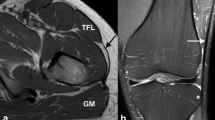Abstract
Objective
To describe the clinical and MR imaging features of a unique strain at the iliac tubercle enthesis. While this strain appeared to correspond to the iliotibial band (IT band) enthesis, the literature regarding the IT band origin was discrepant. As such, our second goal was to prove that the IT band originated at the iliac tubercle, through cadaveric dissection.
Materials and methods
Three musculoskeletal radiologists prospectively reviewed 67 consecutive bony pelvis MRI studies from October 2006 through September 2008 using either 3, 1.5, or 0.3 T units. Seven cases demonstrating strain at the iliac tubercle enthesis were identified and reviewed by consensus. History and patient demographics were reviewed. Cadaveric dissection was performed to delineate the anatomy of the proximal IT band.
Results
Seven out of 67 individuals, all women, were identified with strain at the level of the iliac tubercle (prevalence 10%). Four of seven were athletes, three were overweight. Patients presented with pain and tenderness at the iliac tubercle. Anatomic dissection confirmed that iliotibial band originates along the margin of the iliac crest with dominant fibers condensing on the iliac tubercle.
Conclusion
Proximal IT band strain represents a unique injury that should be considered in patients who are female athletes or older overweight women who present with pain and tenderness at the iliac tubercle. Imaging of this entity must include the iliac tubercle, which is often excluded in standard hip MRI.



Similar content being viewed by others
References
Cvitanic O, Henzie G, Skezas N, Lyons J, Minter J. MRI diagnosis of tears of the hip abductor tendons (gluteus medius and gluteus minimus). AJR Am J Roentgenol. 2004;182:137–43.
Hebert KJ, Laor T, Divine JG, Emery KH, Wall EJ. MRI appearance of chronic stress injury of the iliac crest apophysis in adolescent athletes. AJR Am J Roentgenol. 2008;190:1487–91.
Noble CA. Iliotibial band friction syndrome in runners. Am J Sports Med. 1980;8:232–4.
Martens M, Libbrecht P, Burssens A. Surgical treatment of the iliotibial band syndrome. Am J Sports Med. 1989;17:651–4.
McNicol K, Traunton JE, Clement DB. Iliotibial tract friction syndrome in athletes. Can J Appl Sports Sci. 1981;6:76–80.
Fredericson M, Weir A. Practical management of iliotibial band friction syndrome in runners. Clin J Sport Med. 2006;16(3):261–8.
Murphy BJ, Hechtman KS, Uribe JW, Selesnick H, Smith RL, Zlatkin MB. Iliotibial band friction syndrome: MR imaging findings. Radiology. 1992;185:569–71.
Muhle C, Mo Ahn J, Yeh L, et al. Iliotibial band friction syndrome: MR imaging findings in 16 patients and MR arthrographic study of six cadaveric knees. Radiology. 1999;212:103–10.
Kaplan E. The iliotibial tract: clinical and morphological significance. J Bone Joint Surg Am. 1958;40:817–32.
Hollinshead WH. Anatomy for surgeons, vol. 3. New York: Harper and Row Hoeber Medical Division; 1964.
Birnbaum K, Siebert CH, Pandorf T, Schopphoff E, Prescher A, Niethard FU. Anatomic and biomechanical investigations of the iliotibial tract. Surg Radiol Anat. 2004;26:433–46.
Last RJ. Anatomy regional and applied, 5th ed. Edinburgh: Churchill Livingstone; 1972.
Evans P. The postural function of the iliotibial band. Ann R Coll Surg Engl. 1979;61(4):271–80.
Standring S. Gray's anatomy: the anatomical basis for clinical practice, 39th ed. Elsevier Churchill Livingstone: Edinburgh; 2005.
Netter FH. Atlas of human anatomy, 4th ed. Philadelphia: Saunders Elsevier; 2006.
Agur AMR, Dalley AF. Grant’s atlas of anatomy, 12th ed. New York: Lippincott Williams and Wilkins; 2009.
Kingzett-Taylor A, Tirman PFJ, Feller J, et al. Tendinosis and tears of gluteus medius and minimus muscles as a cause of hip pain: MR imaging findings. AJR Am J Roentgenol. 1999;173:1123–6.
Godon EJ. Trochanteric bursitis and tendinitis. Clin Orthop. 1961;20:193–202.
Ferber R, Davis IM, Williams D Sr. Gender differences in lower extremity mechanics during running. Clin Biomech. 2003;18:350–7.
Chumanov ES, Wall-Scheffler C, Heiderscheit BC. Gender differences in walking and running on level and inclined surfaces. Clin Biomech. 2008;23:1260–8.
Conflict of interest
The authors declare that there is no conflict of interest.
Author information
Authors and Affiliations
Corresponding author
Rights and permissions
About this article
Cite this article
Sher, I., Umans, H., Downie, S.A. et al. Proximal iliotibial band syndrome: what is it and where is it?. Skeletal Radiol 40, 1553–1556 (2011). https://doi.org/10.1007/s00256-011-1168-5
Received:
Revised:
Accepted:
Published:
Issue Date:
DOI: https://doi.org/10.1007/s00256-011-1168-5




